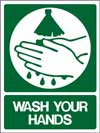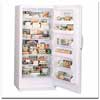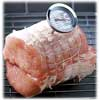Meat Safety and Handling Tps
Meat Cooking & Handling Tips
Now seeking recipe submissions!
Send us an e-mail with your favorite recipe.
If we post it on our site we will include a free gift with your next order and give you credit for your contribution -
you will be FAMOUS!!!
Safe Handling Instructions
We take the utmost care to ensure that our meat is as safe as possible, but still we highly recommend that you follow all the instructions below to protect you and your family from food poisoning. We've copied the information below directly from the Food Safety and Inspection Service, of the US Department of Agriculture. please check out their website for more information.
Preparation

- Always wash hands before and after handling food.
- Don't cross-contaminate. Keep raw meat, poultry, fish, and their juices away from other food.
- After cutting raw meats, wash hands, cutting board, knife, and countertops with hot, soapy water.
- Marinate meat and poultry in a covered dish in the refrigerator.
- Sanitize cutting boards by using a solution of 1 teaspoon chlorine bleach in 1 quart of water
Thawing

- Refrigerator: Planning ahead is the key to this method because of the lengthy time involved. A large frozen item like a turkey requires at least a day (24 hours) for every 5 pounds of weight. Even small amounts of frozen food — such as a pound of ground meat or boneless chicken breasts — require a full day to thaw. When thawing foods in the refrigerator, there are variables to take into account. Some areas of the appliance may keep food colder than other areas. Food will take longer to thaw in a refrigerator set at 35 °F than one set at 40 °F.
After thawing in the refrigerator, items such as ground meat, stew meat, poultry, seafood, should remain safe and good quality for an additional day or two before cooking; red meat cuts (such as beef, pork or lamb roasts, chops and steaks) 3 to 5 days. Food thawed in the refrigerator can be refrozen without cooking, although there may be some loss of quality. - Cold Water: This method is faster than refrigerator thawing but requires more attention. The food must be in a leak-proof package or plastic bag. If the bag leaks, bacteria from the air or surrounding environment could be introduced into the food. Also, the meat tissue may absorb water, resulting in a watery product.
The bag should be submerged in cold tap water, changing the water every 30 minutes so it continues to thaw. Small packages of meat, poultry or seafood — about a pound — may thaw in an hour or less. A 3-to 4-pound package may take 2 to 3 hours. For whole turkeys, estimate about 30 minutes per pound. If thawed completely, the food must be cooked immediately.
Foods thawed by the cold water method should be cooked before refreezing. - Microwave: Microwave Thawing: When thawing food in a microwave, plan to cook it immediately after thawing because some areas of the food may become warm and begin to cook during the thawing process (bringing the food to "Danger Zone" temperatures). Holding partially cooked food is not recommended because any bacteria present wouldn't have been destroyed and, indeed, the food may have reached optimal temperatures for bacteria to grow.
After thawing in the microwave, always cook immediately after, whether microwave cooking, by conventional oven, or grilling.
Foods thawed in the microwave should be cooked before refreezing.
Also, never thaw foods in a garage, basement, car, dishwasher or plastic garbage bag; out on the kitchen counter, outdoors or on the porch. These methods can leave your foods unsafe to eat. - Cooking without Thawing: When there is not enough time to thaw frozen foods, or you're simply in a hurry, just remember: it is safe to cook foods from the frozen state. The cooking will take approximately 50% longer than the recommended time for fully thawed or fresh meat and poultry.
Refreezing

- Meat and poultry defrosted in the refrigerator may be refrozen before or after cooking.
If thawed by other methods, cook before refreezing.
Cooking

- Cook ground meats to 160 °F; ground poultry to 165 °F.
- Beef, veal, and lamb steaks, roasts, and chops may be cooked to 145 °F;
- All cuts of fresh pork, 160 °F.
- Whole poultry should reach 180 °F in the thigh; breasts, 170 °F.
Serving

- Hot food should be held at 140 °F or warmer.
- Cold food should be held at 40 °F or colder.
- When serving food at a buffet, keep food hot with chafing dishes, slow cookers, and warming trays.
- Keep food cold by nesting dishes in bowls of ice or use small serving trays and replace them often.
- Perishable food should not be left out more than 2 hours at room temperature
(1 hour when the temperature is above 90 °F).
Leftovers

- Discard any food left out at room temperature for more than 2 hours
(1 hour if the temperature was above 90 °F). - Place food into shallow containers and immediately put in the refrigerator or freezer for rapid cooling.
- Use cooked leftovers within 4 days.

